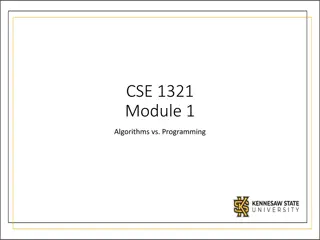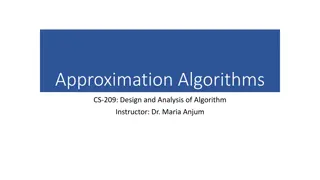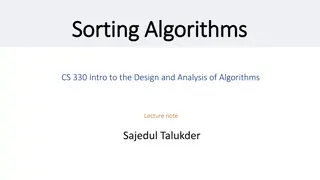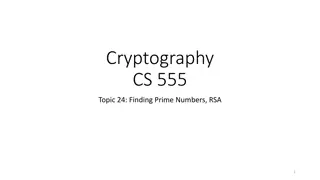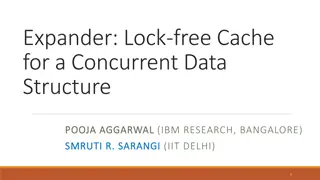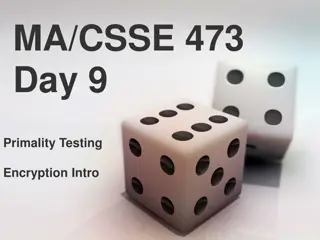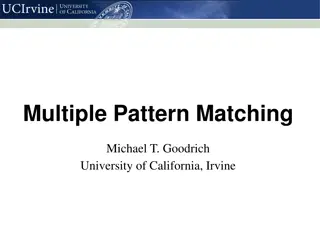
Substring Matching Algorithms and Techniques
Learn about various substring matching algorithms and techniques such as Rabin-Karp, rolling hash, Knuth-Morris-Pratt, and how to deal with repetitive patterns like AAAAAAAAAAAAAAAAAH. Discover the efficiency of hashing in reducing computational complexity and improving search speed for identifying substrings within a larger string.
Download Presentation

Please find below an Image/Link to download the presentation.
The content on the website is provided AS IS for your information and personal use only. It may not be sold, licensed, or shared on other websites without obtaining consent from the author. If you encounter any issues during the download, it is possible that the publisher has removed the file from their server.
You are allowed to download the files provided on this website for personal or commercial use, subject to the condition that they are used lawfully. All files are the property of their respective owners.
The content on the website is provided AS IS for your information and personal use only. It may not be sold, licensed, or shared on other websites without obtaining consent from the author.
E N D
Presentation Transcript
Finding substrings BY Taariq Mowzer
What are we doing? How many times does a string L appear in a string S. E.G How many times does AABA appear in ABABAABAABA. In this case twice: ABAB|AABA|ABA ABABAAB|AABA| Notice the overlap ABAB|AAB|A|ABA|
Rabin-Karp and hashing How to hash a string S? Let p = 1000000007 and k = 3247683247 (some other big prime) Let f(char v) = the position v is in the alphabet e.g f(a) = 1, f(e) = 5. hash ( adeb ) = f( a )*k3+ f( d )*k2+ f( e )*k + f( b ) (mod p)
Whats the point of hashing? If hash(P) hash(Q) then P Q That means we can check less cases. Notice that if hash(P) = hash(Q) does not mean P = Q, so you still have to check if P = Q.
Rolling hash Suppose we re hashing length n = 4. S = abbaaccd hash( abba ) = 1k3+ 2k2+ 2k + 1 ALL mod p hash( bbaa ) = 2k3+ 2k2+1k + 1 hash( baac ) = 2k3+ 1k2+1k + 3 To go from one hash to another:Remove the first letter times k add the next letter
Rabin-Karp Robin- Karp is using the rolling hash and comparing it to our original string to see if they have the same hash. Where n is length of L and m is length of S Average running time of O(n + m) Worst case: O(nm) e.g. L = AAA , S = AAAAAAAAAAAAAAAAAAAAAAAAAH
Knuth-Morris-Pratt How many times does a string L appear in a string S. We use pre-processing. When a mistake occurs we do not start from over but to the shortest prefix that works .
Example L = ABACABAD S = ABACABABACABAD ABACABABACABAD ABACABAD
Example L = ABACABAD S = ABACABABACABAD ABACABABACABAD ABACABAD
Example L = ABACABAD S = ABACABABACABAD ABACABABACABAD ABACABAD
Example L = ABACABAD S = ABACABABACABAD ABACABABACABAD ABACABAD
Example L = ABACABAD S = ABACABABACABAD ABACABABACABAD ABACABAD
Example L = ABACABAD S = ABACABABACABAD ABACABABACABAD ABACABAD
Example L = ABACABAD S = ABACABABACABAD ABACABABACABAD ABACABAD
Example L = ABACABAD S = ABACABABACABAD ABACABABACABAD ABACABAD
Example L = ABACABAD S = ABACABABACABAD ABACABABACABAD instead of ABACABABACABAD ABACABAD ABACABAD
Example L = ABACABAD S = ABACABABACABAD ABACABABACABAD ABACABAD
Example L = ABACABAD S = ABACABABACABAD ABACABABACABAD ABACABAD
Example L = ABACABAD S = ABACABABACABAD ABACABABACABAD ABACABAD
Example L = ABACABAD S = ABACABABACABAD ABACABABACABAD ABACABAD
Example L = ABACABAD S = ABACABABACABAD ABACABABACABAD ABACABAD
Example L = ABACABAD S = ABACABABACABAD ABACABABACABAD ABACABAD
Example L = ABACABAD S = ABACABABACABAD ABACABABACABAD ABACABAD
Example L = ABACABAD S = ABACABABACABAD ABACABABACABAD ABACABAD
Where to fall-back? M[i] is the length of the longest prefix that is also a suffix of L[:i], M[i] i
Where to fall-back? M[i] is the length of the longest prefix that is also a suffix of L[:i], M[i] i L = ABACABAD ABACABAD M[0] = 0
Where to fall-back? M[i] is the length of the longest prefix that is also a suffix of L[:i], M[i] i L = ABACABAD ABACABAD M[0] = 0 ABACABAD M[1] = 0
Where to fall-back? M[i] is the length of the longest prefix that is also a suffix of L[:i], M[i] i L = ABACABAD ABACABAD M[0] = 0 ABACABAD M[1] = 0 ABACABAD M[2] = 0
Where to fall-back? M[i] is the length of the longest prefix that is also a suffix of L[:i], M[i] i L = ABACABAD ABACABAD M[0] = 0 ABACABAD M[1] = 0 ABACABAD M[2] = 0 ABACABAD M[3] = 1
Where to fall-back? M[i] is the length of the longest prefix that is also a suffix of L[:i], M[i] i L = ABACABAD ABACABAD M[0] = 0 ABACABAD M[1] = 0 ABACABAD M[2] = 0 ABACABAD M[3] = 1 ABACABAD M[4] = 0
Where to fall-back? M[i] is the length of the longest prefix that is also a suffix of L[:i], M[i] i L = ABACABAD ABACABAD M[4] = 0 ABACABAD M[5] = 1
Where to fall-back? M[i] is the length of the longest prefix that is also a suffix of L[:i], M[i] i L = ABACABAD ABACABAD M[4] = 0 ABACABAD M[5] = 1 ABACABAD M[6] = 2
Where to fall-back? M[i] is the length of the longest prefix that is also a suffix of L[:i], M[i] i L = ABACABAD ABACABAD M[4] = 0 ABACABAD M[5] = 1 ABACABAD M[6] = 2 ABACABAD M[7] = 3
Where to fall-back? M[i] is the length of the longest prefix that is also a suffix of L[:i], M[i] i L = ABACABAD ABACABAD M[4] = 0 ABACABAD M[5] = 1 ABACABAD M[6] = 2 ABACABAD M[7] = 3 ABACABAD M[8] = 0
Where to fall-back? L = ABABBABABAA ABABBABABAA M[0] = 0
Where to fall-back? L = ABABBABABAA ABABBABABAA ABABBABABAA M[0] = 0 M[1] = 0
Where to fall-back? L = ABABBABABAA ABABBABABAA ABABBABABAA ABABBABABAA M[0] = 0 M[1] = 0 M[2] = 1
Where to fall-back? L = ABABBABABAA ABABBABABAA ABABBABABAA ABABBABABAA ABABBABABAA M[0] = 0 M[1] = 0 M[2] = 1 M[3] = 2
Where to fall-back? L = ABABBABABAA ABABBABABAA ABABBABABAA ABABBABABAA ABABBABABAA ABABBABABAA M[0] = 0 M[1] = 0 M[2] = 1 M[3] = 2 M[4] = 0
Where to fall-back? L = ABABBABABAA ABABBABABAA ABABBABABAA ABABBABABAA ABABBABABAA ABABBABABAA ABABBABABAA M[0] = 0 M[1] = 0 M[2] = 1 M[3] = 2 M[4] = 0 M[5] = 1
Where to fall-back? L = ABABBABABAA ABABBABABAA ABABBABABAA ABABBABABAA ABABBABABAA ABABBABABAA ABABBABABAA ABABBABABAA M[0] = 0 M[1] = 0 M[2] = 1 M[3] = 2 M[4] = 0 M[5] = 1 M[6] = 2
Where to fall-back? L = ABABBABABAA ABABBABABAA ABABBABABAA ABABBABABAA ABABBABABAA ABABBABABAA ABABBABABAA ABABBABABAA ABABBABABAA M[0] = 0 M[1] = 0 M[2] = 1 M[3] = 2 M[4] = 0 M[5] = 1 M[6] = 2 M[7] = 3
Where to fall-back? L = ABABBABABAA ABABBABABAA ABABBABABAA ABABBABABAA ABABBABABAA M[5] = 1 M[6] = 2 M[7] = 3 M[8] = 4
Where to fall-back? L = ABABBABABAA ABABBABABAA ABABBABABAA ABABBABABAA ABABBABABAA ABABBABABAA M[5] = 1 M[6] = 2 M[7] = 3 M[8] = 4 M[9] = 3
Where to fall-back? L = ABABBABABAA ABABBABABAA ABABBABABAA ABABBABABAA ABABBABABAA ABABBABABAA ABABBABABAA M[5] = 1 M[6] = 2 M[7] = 3 M[8] = 4 M[9] = 3 M[10] = 1
How to implement? lenn = 0 \\len is the longest prefix of L that currently matches up to S[i] for i in range(len(S)): while (L[lenn] != S[i] and lenn > 0): \\Change the start until it matches S[i] or is 0 lenn = M[lenn- 1] \\Off by 1 errors will make you suicidal if (L[lenn] == S[i]): len++ If (lenn == L.size()): \\The entire L has been found in S ans++ lenn = M[lenn - 1]
How to find M? You can do the O(n2) which isn t too bad. There is a O(n) which is similar to the previous code .
How to find M? M = [0, 0] lenn = 0 for i in range(1, len(L)): while (L[lenn] != L[i] and lenn > 0): lenn = M[lenn- 1] if (L[lenn] == L[i]): lenn++ M.append(lenn)
Note: For some reason my code is a lot simpler than other sites. So maybe my code is slow or doesn t work. https://www.geeksforgeeks.org/kmp-algorithm-for-pattern-searching/ https://en.wikipedia.org/wiki/Knuth%E2%80%93Morris%E2%80%93Pra tt_algorithm If you need code.

